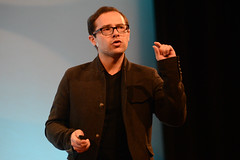 Aza Raskin was named the 2011 Master of Design and one of the top 40 influential designers by Fast Company. Aza is the founder and CEO of Massive Health, and was until recently Creative Lead for Firefox and a founding member of Mozilla Labs.
Aza Raskin was named the 2011 Master of Design and one of the top 40 influential designers by Fast Company. Aza is the founder and CEO of Massive Health, and was until recently Creative Lead for Firefox and a founding member of Mozilla Labs. In his talk at Webstock Aza stated
“it’s not about thinking outside the box. It’s about finding the right box to think inside.”Much of what he discussed can be directly mapped into our thinking for education.
How do we ask the right question? The way to solve a problem is to know how to ask the right question, turn a difficult question into an easier question by changing the way you ask it. Most of the time we are trying to solve the wrong problem because we don’t understand what the problem is.
Aza challenges us to ‘fail forward’. He says it is going to happen so we should plan for it.
The main idea here is that Constraints Create Creativity. So how do obstacles change perceptual and conceptual scopes? Take a look at this example:
Turning an unused crack between two houses into a home
World’s narrowest house video
Constraints force us to think differently. A research report apparently found that if you encounter a detour on your way home you are more likely to eat something different for dinner. Constraints change habits.
It is via the constraint that we can overcome the mundanity and banality, it forces us to break our habits. Focused obstacles and questions are just constraints.
So … what questions lead to a good question?
- The ones that preclude reliable, already recognized answers
- That promote novel ones
- That help you fail forward
This brings to mind the story of three teachers who embraced their constraints and created a new way to teach their students.
Collaborative teaching in a traditional environment from EDtalks.






No comments:
Post a Comment